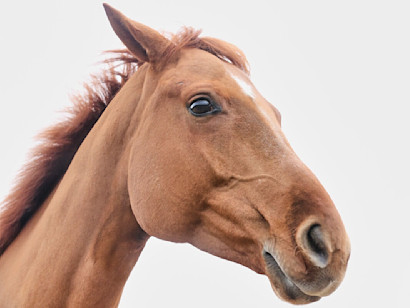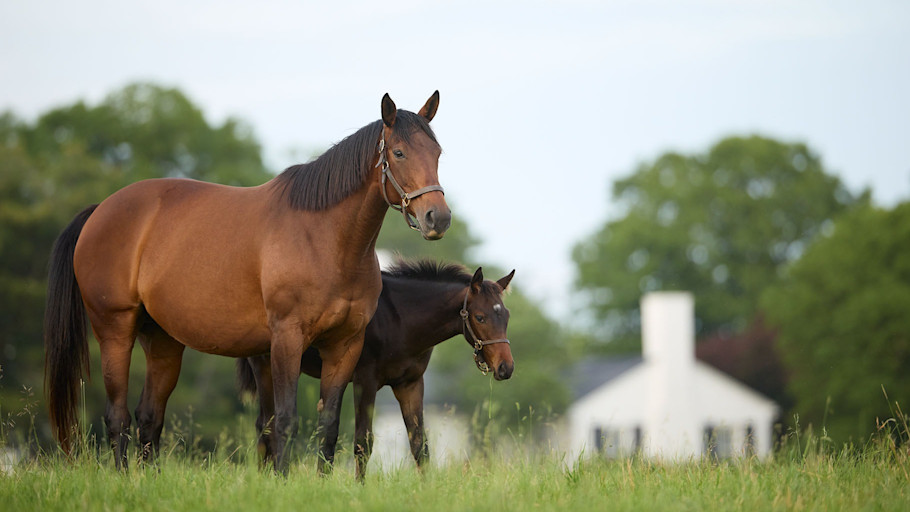Understanding Hormones & Behavioral Changes of Mares in Heat
Why your mare acts differently when in heat and how to support her health
By: Liz Schatz, DVM | Updated September 30, 2025

From pinned ears to distracted rides, “mareish” behavior often stems from a mare’s natural hormonal cycle. Behavioral changes, such as a cranky temperament, unusual excitability, or showing signs of discomfort under saddle can be challenging for owners, riders, and caretakers to handle.
Thankfully, there are some methods to address the causes of a mare’s behavior when she is in heat. To support our mares and help them feel their best, we must first understand their hormone cycle and how it affects them.
The Equine Estrous Cycle Explained
Mares experience a seasonal estrous cycle, which means that most mares have their cycle from about May to October in the northern hemisphere. Each cycle is usually 21 days long, with 7 days in estrus (also called “in season” or “in heat”) and 14 days in diestrus (not in heat). During the winter months, most mares will stop cycling, which is referred to as anestrus.
Hormones Involved in the Estrous Cycle
During anestrus, the ovaries are inactive and the hormones estrogen and progesterone are low. As daylight increases in the spring, the ovaries become active and produce follicles, which are sacs that contain developing eggs. After 3-4 prolonged estrus periods in early spring, during which ovulation does not occur, there is a surge of luteinizing hormone (LH). LH stimulates ovulation of one dominant follicle, which indicates the start of the regular 21-day estrous cycle. Here is a breakdown of the specialized hormones that control the estrous cycle:
- Estrogen: Produced by the developing follicle and peaks during estrus.
- Progesterone: Produced by a special type of follicle, called the corpus luteum (CL). Progesterone is responsible for maintaining the uterine environment in early pregnancies by inhibiting the secretion of luteinizing hormone and follicle stimulating hormone.
- Testosterone: Produced by the ovaries, testosterone increases during estrus, which may contribute to the aggressive behavior sometimes seen in mares throughout this period.
- Gonadotropin-releasing hormone (GnRH): Produced in the hypothalamus. GnRH stimulates the pituitary gland to produce follicle stimulating hormone and luteinizing hormone.
- Follicle stimulating hormone (FSH): Produced in the pituitary gland, FSH stimulates ovarian follicles.
- Luteinizing hormone (LH): Produced in the pituitary gland, LH supports maturation and stimulates ovulation of follicles.
- Prostaglandin (PGF2a): Produced by the uterus if there is no embryo present. PGF2a causes regression of the corpus luteum, which reduces progesterone and allows FSH to increase, starting the estrous cycle over again.
Common Signs a Mare is in Heat
During the 7 days of estrus, mares may show many different signs of being in heat due to the increase in estrogen, including:
- Pinning ears and/or squealing at other horses
- Behaving in a distracted, unfocused, or excitable manner
- Squatting and raising their tail
- Passing small amounts of urine frequently
- “Winking” of the vulva
- Signs of discomfort or pain during ovulation, which may look like colic
While these behaviors may present challenges to equine caretakers, they are all normal signs of estrus. It is important to distinguish these from other causes of discomfort and behavioral issues, such as:
- Colic
- Musculoskeletal pain
- Urinary tract infections
- Ovarian tumors
As always, if you have concerns about your mare’s behavior or comfort, your veterinarian is your best resource.
Practical Tips for Managing a Mare in Heat

- Tracking and recording her cycle: Making notes on a calendar of when your mare starts to exhibit changes in her behavior can be key to understanding her cycle. This may help you better recognize her behavioral patterns and make adjustments to her training schedule as needed.
- Being mindful of her stablemates and turnout group: Some mares may be more reactive to their stablemates – whether fellow mares or geldings and stallions – during estrus. Try to avoid leading a sensitive mare too closely by other horses if she is in heat.
- Monitoring her for signs of discomfort: Pay attention to changes in her behavior, such as being sensitive when groomed or tacked up, as your mare could be uncomfortable.
- Enlisting responsible horse handlers: During estrus, some mares may require an experienced handler due to their behavior, even if they are calm and easygoing when not cycling. Barn managers should be mindful of this to ensure the safety of their staff.
Treatment and Medical Options for Mares in Heat
Mares that experience painful ovulation may require occasional administration of a nonsteroidal anti-inflammatory drug (NSAID), such as phenylbutazone (bute) or flunixin meglumine (Banamine®). These are both relatively inexpensive and effective, plus they can be kept on hand and administered by caretakers as needed.
Prescription Medications Available
Estrus can also be medically halted when it produces severe pain or undesirable behaviors. This is when altrenogest (Regu-Mate®) is used orally on a daily basis. While this product is very effective, it must be used with caution as it is easily absorbed through the skin of handlers. If absorbed, altrenogest may cause disruptions in the menstrual cycles or pregnancies of women. There are a few other methods of controlling estrus in mares, but they are more complicated to administer.
Surgically Removing a Mare’s Ovaries
As a last resort, mares that experience chronic issues with estrus could have their ovaries surgically removed through a procedure called an ovariectomy. This procedure is very effective in halting ovulation (and reproduction), but an ovariectomy is a relatively major surgery that is not without risk. It is important to work closely with your veterinarian to determine your mare’s specific needs when deciding if she requires medical intervention for painful or otherwise problematic estrus.
Supplements That May Lend Support
There are supplements that may help support moody mares through their hormone cycle. Ingredients in these supplements can be sorted into three categories:
- Calming and focus support: Ashwagandha, chamomile, five-flavor fruit, golden root, inositol, magnesium, passion flower, Siberian ginseng, taurine, theanine, thiamine, tryptophan, valerian, and vervain.
- Support for normal hormone levels: Chasteberry, dong quai root, and raspberry leaf.
- General comfort and support for a normal inflammatory response: Boswellia, bromelain, devil’s claw, MSM, turmeric, white willow, and yucca.
Adding some of these into your mare’s daily regimen may help her feel her best, even during difficult estrus periods. If she is feeling better, it may help deter some undesirable behaviors, as well!
Frequently Asked Questions About Mares in Heat

What does it mean when a mare is “in heat?”
When a mare is in heat, she is in the fertile phase of the estrous cycle. Fluctuating hormone levels may contribute to behavioral changes, such as tail-raising and vocalization when near other horses. Mares may be in heat for about 7 days, which indicates that she is ready for breeding.
At what age does a filly become sexually mature and start cycling?
Most fillies reach sexual maturity and begin cycling between 12 and 18 months of age. Female yearlings may begin to exhibit signs of estrus.
Can a mare be in heat while pregnant?
Yes! This can happen for two reasons. Throughout early pregnancy, a mare can grow and regress follicles and even ovulate, causing them to show signs of heat. In late pregnancy, the fetus will start producing their own hormones, which can create signs of heat in the mare. Because there are no changes in the mare’s ovaries in this case, this is called a false heat.
Can you ride a mare in heat?
Generally, this depends on your unique mare’s behavior and whether she is comfortable and safe to handle. Some mares remain focused and work well while in heat, while others may become sensitive, distracted, or irritable. Adjusting your expectations while she is cycling and speaking with your trainer and veterinarian may be helpful when making this decision.